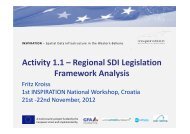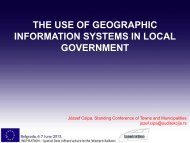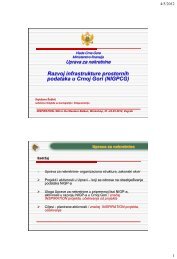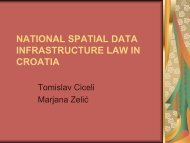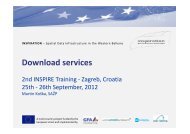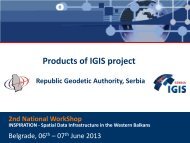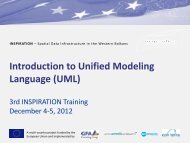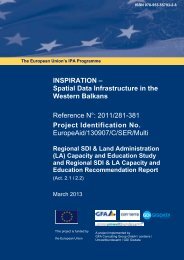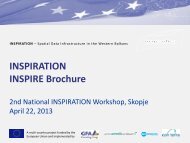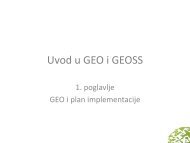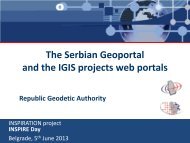MOVE - Moderation and Visualization for Group ... - INSPIRATION
MOVE - Moderation and Visualization for Group ... - INSPIRATION
MOVE - Moderation and Visualization for Group ... - INSPIRATION
You also want an ePaper? Increase the reach of your titles
YUMPU automatically turns print PDFs into web optimized ePapers that Google loves.
■ be able to create an atmosphere of confidence<br />
<strong>and</strong> mutual trust among participants,<br />
■ develop dramaturgic features by flexibly<br />
adapting <strong>and</strong> modifying moderation <strong>and</strong><br />
visualization methods, instruments <strong>and</strong><br />
sequences of steps,<br />
■ possess drawing <strong>and</strong> h<strong>and</strong>writing skills,<br />
■ acquire a sense <strong>for</strong> arranging space,<br />
structure, colors <strong>and</strong> other moderation<br />
elements in order to create an attractive<br />
physical environment.<br />
The Participants<br />
Moderators, of course, cannot be separated from<br />
the participants they cooperate with. The<br />
question “Which types of participants is <strong>MOVE</strong><br />
appropriate <strong>for</strong>?“ is easy to answer: all persons<br />
open to communication <strong>and</strong> cooperation. And<br />
the motivation to communicate can be stimulated<br />
<strong>and</strong> mobilized by a seasoned moderator.<br />
But you should remember that adults are mostly<br />
voluntary learners. Their motivation is highest<br />
when they personally have a chance to decide<br />
what <strong>and</strong> how they learn. Learning, to them, is<br />
an interactive process which appeals to cognitive<br />
capacities as well as to interpersonal relationships<br />
<strong>and</strong> feelings. They learn best when<br />
resource persons <strong>and</strong> support material present<br />
links to their working situations. Also, adults<br />
learn most from peers who share experiences,<br />
assist each other <strong>and</strong> en<strong>for</strong>ce team work. Last but<br />
not least, as was illustrated in Part 1 about “How<br />
we learn” <strong>and</strong> “What we remember”, people learn<br />
<strong>and</strong> remember things best they have developed<br />
24<br />
As you can see, the skills <strong>and</strong> qualities of a<br />
moderator are of particular importance in the<br />
<strong>MOVE</strong> context. True, the success of a training or<br />
meeting greatly depends on a good moderator,<br />
but it depends even more on team work, on the<br />
trustful <strong>and</strong> open cooperation of moderators,<br />
participants, resource persons <strong>and</strong> other people<br />
involved. There<strong>for</strong>e, let’s have a look at the other<br />
people at work.<br />
<strong>and</strong> articulated themselves, preferably in a<br />
visualized way.<br />
This is particularly true <strong>for</strong> illiterate or semiilliterate<br />
participants. <strong>MOVE</strong> works with them,<br />
too, as was frequently proven in rural areas.<br />
There are many examples of successful visualization<br />
through pictures <strong>and</strong> symbols adapted to the<br />
cultural reality of less literate social groups (see<br />
Part 4 on visualization). A very impressive<br />
method is GRAAP - Research <strong>and</strong> Support <strong>Group</strong><br />
<strong>for</strong> Farmers’ Self-Help (see Hoffmann 1995) in a<br />
number of African countries or the Flexiflan<br />
approach used by Indonesian NGO (see Wibowo<br />
1988). Nonetheless, the moderation approach<br />
described in this manual is primarily aimed at<br />
those who know how to write. It has successfully<br />
been used in village settings as well as in office<br />
meetings or international workshops, with a<br />
small or large numbers of participants, with the<br />
young <strong>and</strong> the old, with women <strong>and</strong> men.<br />
Experience has shown that this approach can<br />
integrate even very heterogeneous groups such<br />
as university professors <strong>and</strong> waste pickers in<br />
Indonesian environmental communication<br />
training. However, uneasiness within a given<br />
group of participants is something we sometimes<br />
face as moderators. This must not necessarily<br />
result in conflict. We prefer to speak of<br />
‘difficult situations.’ A funny typology of participants,<br />
their main characteristics, <strong>and</strong> some<br />
recommendations on how to deal with them is<br />
presented overleaf.



